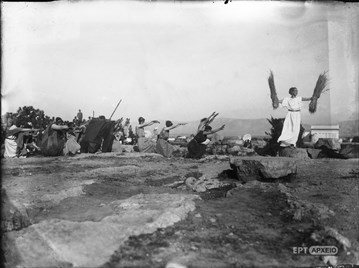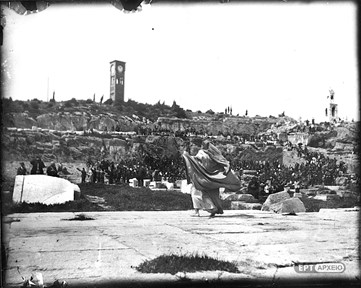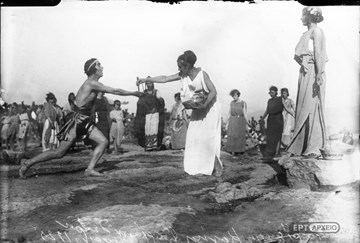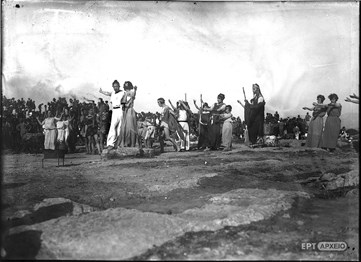Enactment of the story of Demeter and Persephone was part of the dromena. The sacred performance would include music, hymns, and dances with minimal explanations and dialogue. In contrast to a theatrical performance where the spectators remain uninvolved, the mystai would participate in the dromena to come closer to the divine experience. Aristotle states that the mystai did not learn anything new (the myth was widely known) but experienced various emotions and impressions that left them in a particular state of mind. There is no specific information on the mystai participation in the holy enactment. Maybe they wandered searching for Persephone with torches around the Telesterion (but always within the sacred precinct to shield the event from the uninitiated). Many landmarks associated with the myth (Agelastos Petra, Plutoneion) stood near the Telesterion. The mystai would have the opportunity to follow in the footsteps of the goddess Demeter and experience the excitement of the return of Persephone. The nightly representation of the myth accompanied by the light from the torches, the music, and the invocations' utterance was a masterful theatrical experience that remained unforgettable.

Eleusis. Archaeological site. Snapshot from an outdoor reenactment of the Eleusinian Mysteries, 1925, photograph, ΕΡΤ © Αρχείο Ε.Ρ.Τ. Α.Ε., Συλλογή Πέτρου Πουλίδη

Eleusis. Archaeological site. Snapshot from an outdoor reenactment of the Eleusinian Mysteries, 1925, photograph, ΕΡΤ © Αρχείο Ε.Ρ.Τ. Α.Ε., Συλλογή Πέτρου Πουλίδη
Based on quotes from classical and Christian writers, other theories add a supposed simulation of the journey the mystai expected to undertake in the Underworld. The enactment used passages and corridors in the Telesterion to bring them face to face with apparitions and phantoms that caused terror and unrest. However, the architecture of the Telesterion and extant inscriptions rule out this possibility. There are no underground rooms, corridors, or mechanisms for creating these apparitions. The inscriptions also make no references to expenses related to the construction of the required scenery.

Eleusis. Archaeological site. Snapshot from an outdoor reenactment of the Eleusinian Mysteries, 1925, photograph, ΕΡΤ © Αρχείο Ε.Ρ.Τ. Α.Ε., Συλλογή Πέτρου Πουλίδη

Eleusis. Archaeological site. Snapshot from an outdoor reenactment of the Eleusinian Mysteries, 1925, photograph, ΕΡΤ © Αρχείο Ε.Ρ.Τ. Α.Ε., Συλλογή Πέτρου Πουλίδη
Some scholars believe that the dromena portrayed Triptolemus’ mission, a sacred wedding, or sacramental meal. The fact that we know enough alleged facts about these supposed events in the Telesterion is a serious clue that they were not part of what was happening. The words “Hye” and “Kye!” (“Rain” and “Be fruitful”), which the mystai supposedly exclaimed to heaven and earth respectively, has been interpreted as the essential secret part of the Mysteries. The phrase, however, has been found engraved on the mouth of a well near the Dipylon Gate in Athens, one of the city’s busiest spots. It is inconceivable that the Athenians would leave in public view the ceremony’s culmination. As for the feast that Polemon mentions as part of the dromena, the detailed list of ingredients precludes the possibility of forming part of what was happening.








